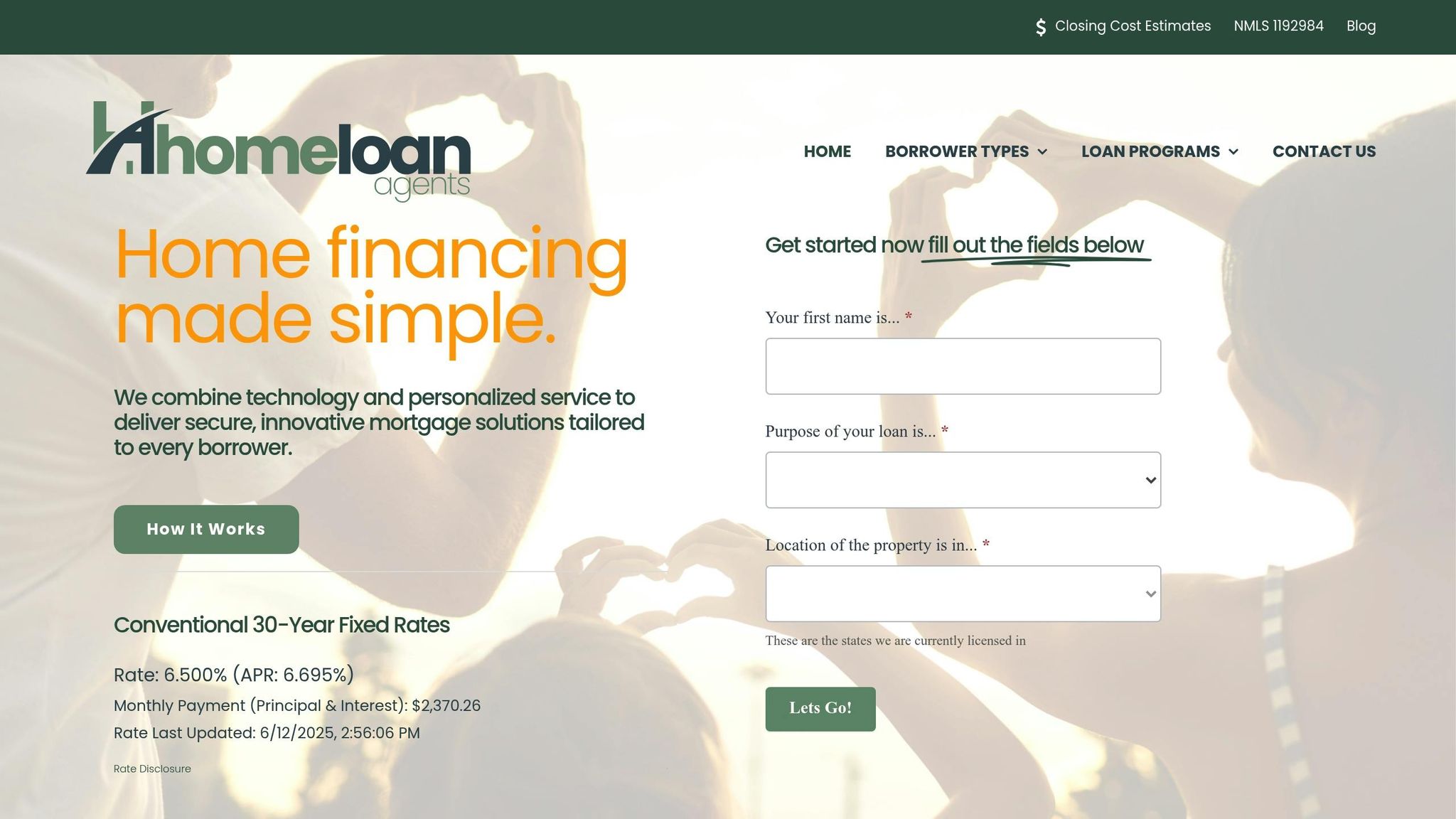Need cash for home improvements, debt consolidation, or other financial goals? You can tap into your home’s equity in two main ways: cash-out refinancing or a home equity loan. Both options let you access funds, but they work differently and suit different needs.
- Cash-Out Refinance: Replace your existing mortgage with a larger one. Benefits include potentially lower interest rates and a single monthly payment. Best for large expenses or when current mortgage rates are lower than your existing rate.
- Home Equity Loan: Add a second loan on top of your current mortgage. It offers fixed payments and lower upfront costs but comes with higher interest rates. Ideal for smaller, one-time expenses or if you want to keep your current mortgage rate.
Quick Comparison
| Feature | Cash-Out Refinance | Home Equity Loan |
|---|---|---|
| Loan Structure | Replaces current mortgage | Adds a second loan |
| Monthly Payments | Single payment | Two payments |
| Interest Rates | Lower (primary loan rates) | Higher (secondary loan rates) |
| Closing Costs | Higher (2%-6% of loan amount) | Lower (2%-5% of loan amount) |
| Best For | Large expenses, refinancing existing rate | Fixed, smaller expenses |
Key takeaway: Choose a cash-out refinance if you want to lower your mortgage rate or need a large sum. Opt for a home equity loan if you want to keep your current mortgage terms or need funds for a specific, smaller expense.
Home Equity Loan vs Refinance: Which Is Better for You?
What Is Cash-Out Refinancing?
Cash-out refinancing lets you replace your current mortgage with a new one that’s larger, giving you access to your home’s equity in the form of cash.
"A cash-out refinance is a type of mortgage refinance that lets you convert your home equity into cash. It replaces your existing home mortgage with a new, larger loan, and pays you the difference between the new and old mortgage amount at closing." – U.S. Bank [5]
This approach is different from a traditional refinance, which focuses on improving your loan terms – like securing a lower interest rate – without changing the loan amount. With cash-out refinancing, you’re borrowing more than what you currently owe, allowing you to tap into your home equity for other financial needs.
The cash you receive isn’t considered taxable because it’s not income; it’s a loan secured by your home’s equity [5]. However, lenders may charge higher fees or interest rates for these loans since they carry more risk compared to traditional refinancing options [4].
How Cash-Out Refinancing Works
The first step in cash-out refinancing is figuring out how much equity you’ve built in your home. Most lenders allow you to borrow up to 80% of your home’s current value, though some may go as high as 90%, depending on the loan type [8].
Here’s an example: If your home is valued at $450,000 and you owe $300,000 on your mortgage, you have $150,000 in equity. With an 80% loan-to-value limit, your maximum loan amount would be $450,000 x 0.80 = $360,000. After paying off your existing mortgage balance of $300,000, you could access $60,000 in cash [6].
The process involves several steps: comparing lenders, applying for the loan, and qualifying based on your credit score, income, and debt-to-income ratio. Most lenders prefer a debt-to-income ratio of 45% or less. While you might qualify with a credit score of 620, a higher score can help you lock in better interest rates [9]. A home appraisal is required to confirm your property’s value and determine the final loan amount [6]. Keep in mind that closing costs, typically 2% to 6% of the loan amount, will also need to be factored into your overall expenses.
When to Consider Cash-Out Refinancing
Knowing how cash-out refinancing works can help you decide if it aligns with your financial goals. This option is particularly helpful when you need a large sum of money. For instance, many homeowners use it to consolidate debt, as mortgage rates are often much lower than credit card or personal loan rates, potentially leading to significant savings.
It’s also a practical choice for funding major home renovations that could increase your property’s value. Additionally, if current mortgage rates are lower than your existing rate, cash-out refinancing offers the chance to secure better terms while accessing extra cash.
That said, borrowing more means increasing your total mortgage debt and possibly extending the repayment period. It’s essential to ensure your new monthly payments fit into your budget and align with your long-term financial plans.
What Is a Home Equity Loan?
A home equity loan, often referred to as a second mortgage, allows you to borrow against the equity in your home in the form of a lump sum. You’ll repay this amount in fixed installments over a set period. Unlike a cash-out refinance, which replaces your current mortgage, a home equity loan adds a second payment to your monthly budget while keeping your original mortgage untouched. Since the loan is secured by your home, your property acts as collateral.
With Americans holding over $32 trillion in home equity [11], this type of financing can be a useful option. However, because it’s a second mortgage, home equity loans often come with higher interest rates compared to primary mortgages. Let’s break down how these loans work and when they might be the right fit for your financial needs.
How Home Equity Loans Work
Home equity loans typically feature fixed interest rates and consistent monthly payments, making them easier to plan for in your budget. The amount you can borrow depends on the difference between your home’s current market value and the balance of your existing mortgage. Lenders use a combined loan-to-value (CLTV) ratio – usually between 80% and 90% of your home’s appraised value – to determine how much you can borrow. This means you’ll generally need to keep 10% to 20% equity in your home.
For example, if your home is worth $400,000 and your mortgage balance is $250,000, you have $150,000 in equity. With an 80% CLTV, you could borrow up to $320,000 in total, leaving $70,000 available after accounting for your first mortgage.
"When considering a home equity loan, compare rates on multiple loan types. A cash-out refinance may be a better option than a home equity loan, depending on how much you need." – Marguerita Cheng, CFP, Chief Executive Officer, Blue Ocean Global Wealth
Repayment terms typically range from 5 to 20 years, though some lenders may offer terms up to 30 years. For instance, a $50,000 loan with an 8.99% APR would cost about $633 per month over 10 years or $402 per month over 30 years [12]. Closing costs for home equity loans generally fall between 2% and 5% of the loan amount, which is often less than what you’d pay for refinancing. As of March 15, 2024, U.S. Bank offered a fixed APR of 7.65% for a 10-year home equity loan on amounts between $50,000 and $99,999, provided the loan-to-value ratio was 60% or less [10].
When to Consider a Home Equity Loan
A home equity loan is most effective when your financial goal involves a predictable, one-time expense. These loans are ideal for situations where you know exactly how much money you need upfront, such as major home renovations, education expenses, or consolidating high-interest debt. Since the full loan amount is disbursed as a lump sum at closing, it’s a practical option when you need immediate access to funds. Plus, the fixed interest rate provides stability, making it easier to plan for long-term repayment.
To qualify, you’ll typically need a FICO® Score of at least 660 [13], and lenders will evaluate your debt-to-income ratio to ensure you can handle the additional monthly payment. Improving your credit score before applying can help you secure a lower interest rate. Keep in mind that your home serves as collateral for the loan, so missing payments could result in foreclosure. For this reason, home equity loans are not recommended for discretionary expenses like vacations, where the financial risks outweigh the benefits.
Key Differences: Cash-Out Refi vs. Home Equity Loan
Both a cash-out refinance and a home equity loan let you tap into your home’s equity, but they work in very different ways. A cash-out refinance replaces your current mortgage with a larger one, while a home equity loan adds a second mortgage with fixed payments, meaning you’ll have two separate monthly bills to manage [2].
The timing of when you get your funds also sets these options apart. With a home equity loan, you receive the money as a lump sum at closing. In contrast, cash-out refinance funds are typically disbursed a few days after closing [1]. Another key difference is that a home equity loan doesn’t affect the terms of your original mortgage, while a cash-out refinance resets those terms entirely [1].
Comparison Table: Features and Costs
Here’s a side-by-side look at the key features and costs of these two options:
| Feature | Cash-Out Refinance | Home Equity Loan |
|---|---|---|
| Loan Structure | Replaces current mortgage with a new, larger loan | Adds a second mortgage to your existing loan |
| Monthly Payments | One payment (new mortgage) | Two payments (existing mortgage + new loan) |
| Interest Rates | Lower (primary loan) | Higher (secondary loan) |
| Rate Type | Fixed or adjustable | Fixed |
| Closing Costs | Higher (2% – 6% of loan amount) [2] | Lower, sometimes none |
| Loan Terms | 15 or 30 years | 5 to 30 years |
| Maximum LTV | Up to 80% | 80% to 90% |
| Cash Disbursement | A few days after closing | At closing |
Cash-out refinances generally come with lower interest rates because they are considered primary loans, which lenders view as less risky [2]. However, the tradeoff is higher closing costs, ranging from 2% to 6% of the loan amount. On the other hand, home equity loans usually have lower upfront fees [2].
"It’s the cheapest way to borrow against the equity in your home." – Melissa Cohn, Regional Vice President, William Raveis Mortgage [15]
Impact on Your Finances
The financial impact of these options varies significantly, as shown in the comparison above. Both will increase your total debt, but they influence your monthly budget differently. A cash-out refinance results in a single, higher monthly payment that replaces your current mortgage payment. The exact amount depends on how much you borrow and the new interest rate.
In contrast, a home equity loan adds a second fixed monthly payment while keeping your original mortgage unchanged [2]. While this setup might complicate your budgeting, it allows you to preserve the terms of your primary mortgage.
"For homeowners whose primary mortgage rate is below the current market rates, a home equity loan is more likely to be the better choice. By choosing this option, it allows them to keep the low rate they have while also allowing them to tap into the equity they have in their home." – Nicole Straub, SVP and Head of Discover Home Loans [15]
Over time, a cash-out refinance could increase both your monthly payments and the total interest you pay across the loan’s lifespan [7]. Since it resets your mortgage to a new 15- or 30-year term, you may end up paying interest for a much longer period compared to your original loan.
Meanwhile, home equity loans offer more predictable costs thanks to their fixed interest rates, ensuring consistent monthly payments throughout the loan term [16]. However, the higher interest rates associated with these loans can still lead to significant borrowing costs in the long run.
Your choice should also factor in how long you plan to stay in your home. If you’re planning to move or sell soon, a cash-out refinance might not be the best option due to its higher closing costs, which you may not recover. In contrast, home equity loans – with their lower upfront costs – are less influenced by how long you stay in the home. These considerations are essential when deciding which option aligns best with your financial goals.
sbb-itb-8115fc4
Pros and Cons of Each Option
Understanding the advantages and disadvantages of each option is key to making an informed financial decision. Below, we break down the pros and cons to help you determine which choice best aligns with your goals.
Cash-out refinancing replaces your current mortgage with a larger loan, providing a lump sum and a single monthly payment. However, it comes with higher closing costs (typically 2%-5%) and resets your mortgage term [5][18].
On the other hand, home equity loans allow you to keep your existing mortgage while providing a fixed lump sum at predictable rates and lower closing costs. This can be ideal for fixed expenses, but it adds a second payment and typically comes with higher interest rates. The table below outlines these differences.
"With a fixed interest rate and predictable monthly payment, a home equity loan can be a relatively low-cost way to access the equity in your home. You could lose your home if you can’t make the payments, however." – Jennifer Brozic [13]
Benefits and Drawbacks Table
To better understand how these options differ, here’s a side-by-side comparison:
| Aspect | Cash-Out Refinance | Home Equity Loan |
|---|---|---|
| Advantages | • Lower interest rates (as a primary loan) • Single monthly payment • Access to a large lump sum • Potential to improve mortgage terms |
• Keeps your current mortgage rate intact • Fixed interest rates • Lower closing costs |
| Disadvantages | • Higher closing costs (2%-5% of the loan) [5] • Resets mortgage term [18] • Can increase monthly payments • Takes 30–45 days to process [5] |
• Higher interest rates (average 8.24%) [17] • Two monthly payments to manage • Limited borrowing amounts • Risk of foreclosure on the second lien |
| Best For | Homeowners looking to refinance, those needing larger sums, or those with higher current rates | Homeowners with favorable existing mortgage rates, smaller borrowing needs, or fixed project costs |
Key Considerations
The choice between these options can have a major financial impact. As of June 2025, refinance rates average 6.95% for 30-year fixed loans and 6.25% for 15-year fixed loans, while home equity loan rates average 8.24% [17]. With larger loans, even a small difference in rates can lead to significant savings over time.
Your current mortgage rate is a critical factor. If your rate is lower than current refinance rates, a home equity loan might make more sense. On the other hand, if refinancing offers a lower rate than your existing one, a cash-out refinance could help reduce your overall costs [14].
According to ICE Mortgage Technology’s March 2025 report, the average homeowner has about $203,000 in accessible equity [13]. However, most lenders require you to maintain at least 20% equity in your home [2].
Both options come with risks. A cash-out refinance consolidates your debt into one loan, while a home equity loan adds a second lien on your property. Missing payments on either could lead to foreclosure, so careful planning is essential.
How to Choose the Right Option for Your Needs
Deciding between a cash-out refinance and a home equity loan boils down to your financial goals and current situation. It’s essential to think about your purpose, how long you plan to stay in your home, and the terms of your existing mortgage.
"Both cash‑out refinances and home‑equity loans can unlock the value you’ve built in your home – the key is choosing the option that fits your bigger picture." – Eric Rosenberg, Financial Writer, Speaker, and Consultant [2]
If your current mortgage rate is high, a cash-out refinance might be the better choice. On the other hand, if you already have a low rate, a home equity loan can help you access funds while keeping your favorable terms intact [14]. Let’s explore how these options align with specific financial needs.
Debt Consolidation
If you’re looking to streamline your monthly payments, debt consolidation could be a smart move. A cash-out refinance allows you to combine multiple debts into one mortgage payment, often at a lower interest rate than your existing mortgage. This can simplify your finances and potentially lower your overall costs.
Alternatively, a home equity loan is a good option if you only need to consolidate smaller amounts. It lets you access the cash you need without adjusting your primary mortgage, keeping things separate and manageable.
Home Improvements
Need funds for home upgrades? A cash-out refinance is ideal for large-scale renovations or whole-house projects. It provides a significant lump sum at mortgage rates and may even offer tax benefits if the money is used for home improvements [3].
For smaller, clearly defined projects, a home equity loan is a better fit. It provides a fixed amount with predictable monthly payments, making it easier to stick to a budget while preserving your current mortgage rate [21]. Keep in mind, though, that tax considerations can vary, so consulting a professional is a wise step.
Short-Term vs. Long-Term Goals
Timing plays a big role in your decision. If you’re planning to move within three to five years, a home equity loan might make more sense, as it avoids the upfront closing costs of a cash-out refinance (typically 2%–6% of the loan amount). However, for long-term homeowners, a cash-out refinance offers lower rates and the convenience of a single payment.
Your financial stability is another factor. If you’re comfortable managing separate payments, a home equity loan could work well. But if you want simplicity and potentially lower overall costs, a cash-out refinance might be the better route.
No matter which option you’re considering, it’s crucial to shop around. Compare offers from several lenders to find the best rates and terms [19]. Double-check that the numbers fit your budget and goals, and consult a financial advisor to ensure you’re making the right choice for your unique circumstances [20].
Why HomeLoanAgents Is Your Trusted Mortgage Partner
When deciding between a cash-out refinance and a home equity loan, the right lender can make all the difference. HomeLoanAgents blends cutting-edge technology with a personal touch to create a mortgage experience that’s efficient and tailored to your unique situation. Whether you’re refinancing or tapping into your home equity, their digital expertise supports every step of your financial journey.
Advanced Digital Processing
HomeLoanAgents uses advanced digital verification to streamline loan applications, offering a faster and safer alternative to traditional manual methods [22]. This technology is accepted by Fannie Mae and Freddie Mac, ensuring your application meets industry standards [22].
Their digital platform simplifies the mortgage process, enhances transparency, and improves communication among all parties involved [24]. It also allows for easy document uploads and management, making the experience more convenient. On average, technology-based lenders process applications about 20% faster than traditional lenders [27]. Here’s what recent data shows: 82% of homeowners prefer e-signing documents before closing, and over two-thirds of borrowers would choose remote closings over in-person meetings [26].
Personalized Solutions for Every Situation
Beyond their technological edge, HomeLoanAgents prioritizes personalized service to help every borrower find the best solution. Whether you’re exploring a cash-out refinance or a home equity loan, they offer tailored programs to meet your needs. Options include down payments as low as 3%, income-limited programs, and flexible arrangements involving cosigners or gift funds [23]. By leveraging AI and machine learning, they assess your financial profile holistically, paving the way for customized mortgage solutions [24]. This approach also allows their team to focus on providing exceptional customer service and fostering strong client relationships [24].
With licensing in 10 states, including key markets like California, Texas, and Florida, HomeLoanAgents demonstrates their commitment to serving borrowers while adhering to state and federal regulations [23].
Meeting Modern Expectations
Borrowers today expect transparency and efficiency [26], and HomeLoanAgents delivers on both. Their digital platform is designed with the customer in mind [25], recognizing that people want streamlined, modern service in every aspect of their financial lives. With 87% of borrowers selecting lenders based on referrals or existing relationships [26], HomeLoanAgents invests in trust-building through dependable service and innovative solutions. Between 2010 and 2016, tech-driven lenders grew their share of the U.S. mortgage market from 2% to 8% [27], highlighting the increasing demand for technology-enabled mortgage experiences.
HomeLoanAgents combines the tools, expertise, and personalized care you need to navigate your mortgage process with confidence and ease.
Conclusion
Deciding between a cash-out refinance and a home equity loan comes down to your financial goals and current situation. Both options let you access your home’s equity, but they work differently and suit different needs. Here’s a quick breakdown to help you weigh your options.
Cash-out refinancing can be a smart move if you want to lower your current mortgage rate while pulling out extra cash. This option replaces your existing mortgage with a larger one, potentially reducing your overall interest rate.
On the other hand, home equity loans are better suited for homeowners who want to keep their existing low mortgage rate. As Nicole Straub points out:
"For homeowners whose primary mortgage rate is below the current market rates, a home equity loan is more likely to be the better choice. By choosing this option, it allows them to keep the low rate they have while also allowing them to tap into the equity they have in their home" [15].
With home equity loans, rates typically range from 8.25% to 8.40% [28]. While this means paying a higher interest rate on the borrowed amount, your original mortgage remains untouched.
Ultimately, your decision should be guided by your financial priorities. Whether you’re consolidating high-interest debt, tackling major home renovations, or addressing other needs, carefully compare the long-term costs, closing fees, monthly payments, and how long you plan to stay in your home. It’s a good idea to crunch the numbers and get quotes from at least three lenders to find the best terms. Keep in mind that both options carry the risk of foreclosure if payments are missed.
Choose the route that aligns with your financial situation, future goals, and comfort level with adjusting your current mortgage.
FAQs
Which is better if I’m planning to sell my home soon: a cash-out refinance or a home equity loan?
If you’re thinking about selling your home soon, a home equity loan could be the smarter route. Why? It generally comes with lower closing costs and gives you the flexibility to pay off the loan once your home sells. This way, you avoid locking yourself into a long-term financial commitment.
In contrast, a cash-out refinance might not be the best fit for short-term goals. Since it requires refinancing your entire mortgage, it often involves higher upfront costs and extends your repayment term. That could make things more complicated if you’re planning to sell in the near future.
For short-term needs – like sprucing up your home before listing it or consolidating some debt before your move – a home equity loan is usually the way to go.
What risks should I consider with a cash-out refinance or home equity loan, and how can I reduce them?
Both cash-out refinancing and home equity loans come with risks because they involve using your home as collateral. If you miss payments, you could face foreclosure. Other challenges include potentially higher interest rates, accumulating more debt than you can handle, and reducing the equity you’ve built in your home.
To minimize these risks, borrow only what you genuinely need and have a solid repayment plan in place. Stick to a budget that ensures you can comfortably handle your monthly payments. It’s a good idea to maintain at least 20% equity in your home to provide a financial safety net and safeguard your investment. Lastly, avoid depending on future refinancing options to manage your debt – market conditions can shift unpredictably.
Can I use the money from a cash-out refinance or home equity loan for things other than home improvements, like starting a business or investing?
If you’re considering a cash-out refinance or a home equity loan, the good news is that the funds can be used for more than just home improvements. These financial tools tap into your home’s equity, giving you access to a lump sum of cash that can be directed toward various goals. Whether you’re looking to kick off a business venture, invest, cover educational expenses, or consolidate high-interest debt, these options offer flexibility.
That said, it’s crucial to remember that both involve borrowing against your home, meaning your property acts as collateral. Before proceeding, take the time to assess your financial situation and think about your long-term plans. This step ensures you’re making a choice that aligns with your overall financial well-being.
Related posts








